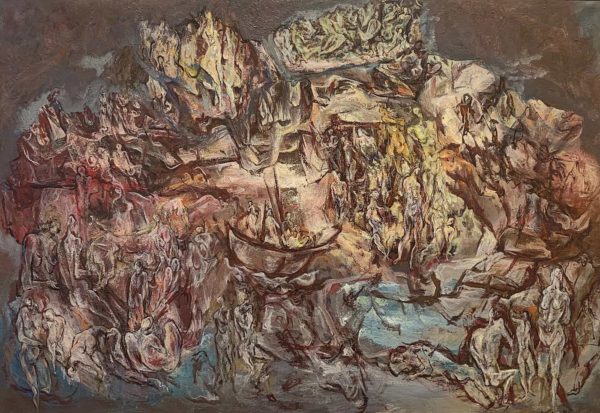“What interests me is interrelationship of man and nature in one sense- the rhythm of the wind and the wind currents and the patterns in the sand and the rhythm in the waves and the bloodstreams in human beings and animals and everything….rhythms underlie everything and part of the unifying thing of everything — that moves in life…” — Kenneth Callahan
Longtime Art Critic, Deloris Tarzan Ament, wrote, “In 1963, Kenneth Callahan’s mountain studio at Granite Falls was destroyed by fire, which took many of his paintings. The Callahan’s had built the cabin together on a 145-acres of woods they had purchased in 1946. Kenneth was traveling in Europe when he received the news of the cabin’s destruction. It was a time for a new beginning. Kenneth and his wife moved to a house on the Washington Coast, sand dunes and tall beach-grass led from the house to the beach.
His new canvases echoed the seaweed and random flotsam washed onto the beach, rendered with a loose dark sweep of the brush blotted with a crumpled rag to pick up random fragments of wet paint. Callahan over-painted the resulting voids to suggest the presence of fleeting, ghostly forms that emerge and change, dissolving into the shadows of other shapes. In the background, vivid orange whorls might swoop across the sky. Flecked explosions of color imply the penetration of another dimension.”
Kenneth Callahan (1905-1986), served as a catalyst for Seattle artists in the mid-20th century through his own painting, his work as director of the Seattle Art Museum and his writings about contemporary art. Born in Spokane and largely self-taught as an artist, Callahan was committed to an art that went beyond the merely illustrative. He traveled widely, absorbing influences from the different countries and cultures he experienced.
His talent was recognized early; his work was included in the first Whitney Biennial Exhibition in 1933 and he went on to a distinguished painting career. Callahan is identified as one of the Northwest Mystics- along with Guy Anderson (1906-1998), Morris Graves (1910-2001), and Mark Tobey (1890-1976)- who all shared a muted palette and strong interest in Asian aesthetics.
